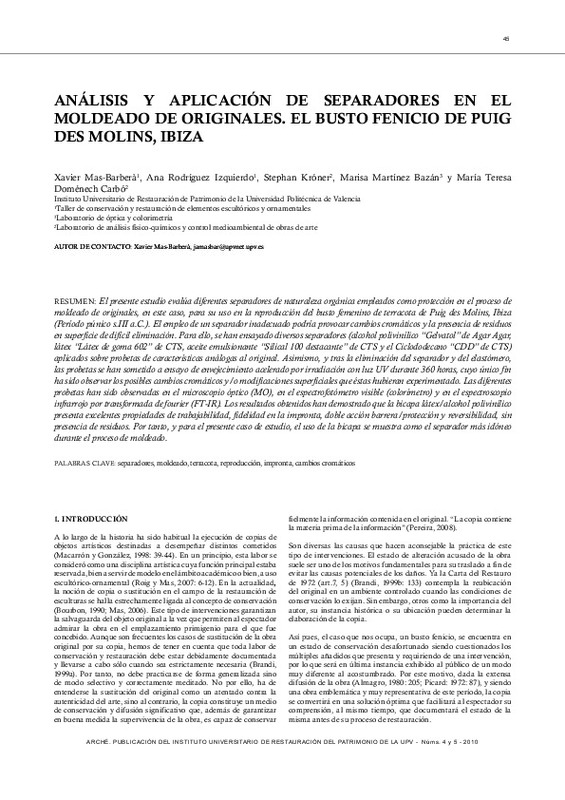|
Resumen:
|
El presente estudio evalúa diferentes separadores de naturaleza orgánica empleados como protección en el proceso de moldeado de originales, en este caso, para su uso en la reproducción del busto femenino de terracota de ...[+]
El presente estudio evalúa diferentes separadores de naturaleza orgánica empleados como protección en el proceso de moldeado de originales, en este caso, para su uso en la reproducción del busto femenino de terracota de Puig des Molins, Ibiza (Período púnico s.III a.C.). El empleo de un separador inadecuado podría provocar cambios cromáticos y la presencia de residuos en superficie de difícil eliminación. Para ello, se han ensayado diversos separadores (alcohol polivinílico ¿Gelvatol¿ de Agar Agar, látex ¿Látex de goma 602¿ de CTS, aceite emulsionante ¿Silical 100 destacante¿ de CTS y el Ciclododecano ¿CDD¿ de CTS) aplicados sobre probetas de características análogas al original. Asimismo, y tras la eliminación del separador y del elastómero, las probetas se han sometido a ensayo de envejecimiento acelerado por irradiación con luz UV durante 360 horas, cuyo único fin ha sido observar los posibles cambios cromáticos y/o modificaciones superficiales que éstas hubieran experimentado. Las diferentes probetas han sido observadas en el microscopio óptico (MO), en el espectrofotómetro visible (colorímetro) y en el espectroscopio infrarrojo por transformada de fourier (FT-IR). Los resultados obtenidos han demostrado que la bicapa látex/alcohol polivinílico presenta excelentes propiedades de trabajabilidad, fidelidad en la impronta, doble acción barrera/protección y reversibilidad, sin presencia de residuos. Por tanto, y para el presente caso de estudio, el uso de la bicapa se muestra como el separador más idóneo durante el proceso de moldeado.
[-]
This study assesses different organic separators used as protection in the process of moulding originals, in this case, for use in reproduction of the female terracotta bust in Puig des Molins, Ibiza (Punic age, 3rd Century ...[+]
This study assesses different organic separators used as protection in the process of moulding originals, in this case, for use in reproduction of the female terracotta bust in Puig des Molins, Ibiza (Punic age, 3rd Century B.C.). The use of an inappropriate separator could cause chromatic changes and the presence of residues on the surface which are difficult to remove. Different separators have been tested to this end (polyvinyl alcohol ¿Gelvatol¿ by Agar Agar, latex ¿Rubber latex 602¿ by CTS, emulsifying oil ¿Silical 100 destacante¿ by CTS and the Cyclododecane ¿CDD¿ by CTS) applied on test pieces with characteristics similar to the original. After elimination of the separators and the elastomer, the test pieces were furthermore subjected to accelerated ageing test by UV light irradiation for 360 hours, with the sole purpose of observing the possible chromatic changes and/or surface modifications that these had undergone. The different test pieces were observed under the optical microscope (OM) and the visible spectrophotometer (colorimeter) and in the infrared spectroscope by Fourier transform (FT-IR). The results obtained have shown that the dual latex/polyvinyl alcohol layer has excellent workability properties, accuracy in the impression, dual barrier/protection effect and reversibility, without any presence of residues. Hence, for the present case studied, the use of the dual layer has come forward as the most ideal separator during the moulding process
[-]
|







